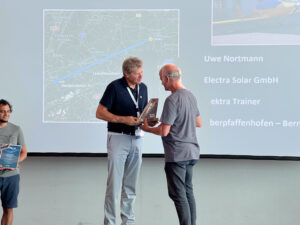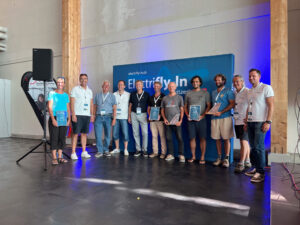A Second Win
Having just come in a close second in a race against an electric car, Elektra Solar’s Trainer attained a Personal Best in range for a flight between Munich, Germany and Bern, Switzerland, a distance of 313 kilometers (194.5 miles). Calin Gologan noted the route from its home field in München Oberpfaffenhofen to Bern Airport) was highly symbolic, starting from the site where, “We founded the company (Elektra Solar) 10 years ago as a startup from the DLR Institute of Robotics and Mechatronics in Oberpfaffenhofen. We were now able to fly our aircraft purely electrically from the DLR location directly to the Electrifly-in location in Bern.” Pilot Uwe Nortmann flew in both outings, both extending the range achieved by this type of electric aircraft.

Uwe Nortmann receives 2023 Electrifly-in trophy for his record flight to Bern. Photo Credit: “Jon Jegerlehner / EFIS” Contact: fotojeger.ch
As Calin points out on his Facebook page, “Last year we won this contest with a leg of about 190 km (118.1 miles). A huge progress in one year.” Looking forward to closing the gap between “e-mobility on the road and e-mobility in the air,” Calin will try for a 400-kilometer (248.5 mile) leg next year and a 500-kilometer (310.7 mile) goal in three years.
He adds for the record, “Charles Lindbergh crossed in 1927 the Atlantic Ocean. Ten years later airliners did the same.” (Also for the record, your editor’s father flew as part of a crew on a C-54, a military version of the Douglas DC-4, from Bangor, Maine to Shannon, Ireland 15 years after Lindbergh.
The Flight to Bern
Flying from its home field in Germany to Bern, Switzerland certainly highlighted the strides Elektra Solar and its battery suppliers have made in the last few years. Another aspect is Calin Gologan’s ability to hew weight from his aircrafts’ structures.
Twelve years ago, this blog reported on Elektra One, the first of many machines that would exemplify Gologan’s skills with composite sandwich structures. Given the energy density of batteries then, the one-third of the entire aircraft’s weight they represented was necessary. 100 kilograms (220 pounds) for batteries, 100 kilograms for the aircraft total weight (only about 100 pounds of which was structural), and 100 kilograms for pilot and equipment weight enabled an ultralight craft that was an attractive addition to any flight line.
Calin’s introduction to Elektra One may have seemed a bit optimistic, but later developments showed what it could do, and those capabilities are more than expanded with the Trainer. It shows the same 1/3 structure, 1/3 battery, and 1/3 payload weights of the earlier design, while continuing with excellent performance and range.
Elektra Solar says, “As already reported, ELEKTRA TRAINER received approval as the first electric aircraft in the German UL class at the beginning of 2023. The first small series of these aircraft is already being produced in Landsberg aL.”

Uwe Nortmann is the center of attention at this year’s Electrifly-in awards presentation. Photo Credit: “Jon Jegerlehner / EFIS” Contact: fotojeger.ch
Having shown the craft to more than a thousand visitors at its home base, Elektra Solar adds the following:
“Customers can order the aircraft with a bipod landing gear (non-retractable). Flight schools will be particularly happy about this version.
“As an option we offer additional batteries (approx. 12 kWh), which are initially attached to the second pilot seat. This means that the flight time in a single seat can be extended by approx. 1 hour, i.e. up to 3.5 hours.
“As an option, we offer a trailer system with which you can completely unload and rig the aircraft or dismantle and stow it again in just one hour. This means that the aircraft can also be used without a hangar to save money.”
Considering the Trainer can enable flights between many major European cities, its utility should be a great enhancement for promoting electric flight.
Featured image:

